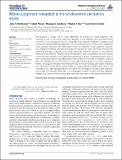Files in this item
Moral judgment reloaded : a moral dilemma validation study
Item metadata
| dc.contributor.author | Christensen, Julia F. | |
| dc.contributor.author | Flexas, Albert | |
| dc.contributor.author | Calabrese, Margareta | |
| dc.contributor.author | Gut, Nadine K. | |
| dc.contributor.author | Gomila, Antoni | |
| dc.date.accessioned | 2014-08-11T15:31:01Z | |
| dc.date.available | 2014-08-11T15:31:01Z | |
| dc.date.issued | 2014-07-01 | |
| dc.identifier | 139609089 | |
| dc.identifier | dca3d4f6-bc05-4260-98e9-ada8232941cb | |
| dc.identifier | 000338742400001 | |
| dc.identifier | 84904858620 | |
| dc.identifier | 000338742400001 | |
| dc.identifier.citation | Christensen , J F , Flexas , A , Calabrese , M , Gut , N K & Gomila , A 2014 , ' Moral judgment reloaded : a moral dilemma validation study ' , Frontiers in Psychology , vol. 5 , 607 . https://doi.org/10.3389/fpsyg.2014.00607 | en |
| dc.identifier.issn | 1664-1078 | |
| dc.identifier.uri | https://hdl.handle.net/10023/5109 | |
| dc.description | The study was funded by the research project FFI2010-20759 (Spanish Government: Ministry of Economy and Competitiveness), and by the Chair of the Three Religions (Government of the Balearic Islands) of the University of the Balearic Islands, Spain. Julia F. Christensen and Albert Flexas were supported by FPU PHD scholarships from the Spanish Ministry of Education, Culture and Sports (AP2009-2889 and AP2008-02284). Nadine K. Gut was supported by a scholarship of the School of Psychology and Neuroscience, University of St Andrews, UK. | en |
| dc.description.abstract | We propose a revised set of moral dilemmas for studies on moral judgment. We selected a total of 46 moral dilemmas available in the literature and fine-tuned them in terms of four conceptual factors (Personal Force, Benefit Recipient, Evitability, and Intention) and methodological aspects of the dilemma formulation (word count, expression style, question formats) that have been shown to influence moral judgment. Second, we obtained normative codings of arousal and valence for each dilemma showing that emotional arousal in response to moral dilemmas depends crucially on the factors Personal Force, Benefit Recipient, and Intentionality. Third, we validated the dilemma set confirming that people's moral judgment is sensitive to all four conceptual factors, and to their interactions. Results are discussed in the context of this field of research, outlining also the relevance of our RT effects for the Dual Process account of moral judgment. Finally, we suggest tentative theoretical avenues for future testing, particularly stressing the importance of the factor Intentionality in moral judgment. Additionally, due to the importance of cross cultural studies in the quest for universals in human moral cognition, we provide the new set dilemmas in six languages (English, French, German, Spanish, Catalan, and Danish). The norming values provided here refer to the Spanish dilemma set. | |
| dc.format.extent | 18 | |
| dc.format.extent | 1530177 | |
| dc.language.iso | eng | |
| dc.relation.ispartof | Frontiers in Psychology | en |
| dc.subject | Moral dilemmas | en |
| dc.subject | Moral judgment | en |
| dc.subject | Decision making | en |
| dc.subject | Cross cultural | en |
| dc.subject | DPHMJ | en |
| dc.subject | Personal/impersonal distinction | en |
| dc.subject | Individual-differences | en |
| dc.subject | Psychology research | en |
| dc.subject | Intuitions | en |
| dc.subject | Intention | en |
| dc.subject | Empathy | en |
| dc.subject | Damage | en |
| dc.subject | Model | en |
| dc.subject | Harm | en |
| dc.subject | BF Psychology | en |
| dc.subject.lcc | BF | en |
| dc.title | Moral judgment reloaded : a moral dilemma validation study | en |
| dc.type | Journal article | en |
| dc.contributor.institution | University of St Andrews. School of Psychology and Neuroscience | en |
| dc.identifier.doi | 10.3389/fpsyg.2014.00607 | |
| dc.description.status | Peer reviewed | en |
This item appears in the following Collection(s)
Items in the St Andrews Research Repository are protected by copyright, with all rights reserved, unless otherwise indicated.

